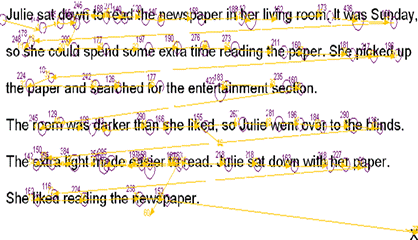DR. GARY RANEY
Associate Professor, Psychology Department, University of Illinois at Chicago
PROJECTS
FIGURATIVE LANGUAGE
My graduate students and I are studying how readers process figurative language, such as metaphors (e.g., my roommate is a pig). Basically we are trying to understand how the key words (such as roommate and pig) are linked together. Recently we have begun exploring whether bilinguals process unfamiliar metaphors more efficiently than non-bilinguals. We are also exploring how idioms (e.g., blew his top) are processed. Here the issue is whether an idiom directly activates an underlying concept (e.g., anger, in the case of “blew his top”). A second issue is whether idioms are processed word-by-word (like literal statements) or retrieved and processed as a single meaning unit (sort of like a very long word).
TRANSFER BENEFITS AND REPETITION EFFECTS
One of my primary areas of interest is transfer benefits and repetition effects. Transfer benefits refer to how reading one text influences reading a second text. For example, reading a text about metaphors is likely to help someone understand a text about idioms because both texts describe figurative language. That is, your knowledge about the metaphor text transfers to the idiom text. Currently I am following up on a prior study to example whether information from one text can facilitate processing of information in an unrelated text. My goal is to use transfer benefits and repetition effects as measures of comprehension (better comprehension seems to produce larger transfer benefits and repetition effects).
BILINGUAL COGNITION AND TEXT COMPREHENSION
The purpose of this line of research is to explore the cognitive mechanisms bilinguals use to select the language they want to use. We are particularly interested whether one language is inhibited as a mechanism for language selection and how attention influences word processing. We are running a second project that explores how language proficiency affects word processing skills in bilinguals who are not proficient in their second language (late learners of an L2). My general goal is to understand how bilinguals’ languages are represented in memory and accessed, and to develop tools for assessing the efficiency of the cognitive processes involved in reading. I have been working with English-Spanish bilinguals, but I recently started a collaborative project with a colleague from Canada that will use English, French, and Spanish. Outside the language domain, I am exploring whether proficient bilinguals have an advantage over monolinguals in demanding tasks such as solving insight problems.
EYE TRACKERS IN MY LAB

I have used three eye trackers in my lab. Currently I am using an SR-Research EyeLink 1000. This is a video-based eye tracker that records eye position 1000 times per second. I published in article in JoVE (Journal of Visualized Experiments) that includes a video describing how to use eye movements to study reading processes. The video an article are available at http://www.jove.com/video/50780. The picture below shows the desktop mount version of this eye tracker (left panel) and the experimenter’s display on the computer (right panel). The experimenter’s display shows a picture of the face and a close up of the right eye. The blue region is the pupil. The model in the picture is a former graduate student. I began using this eye tracker in May, 2006. It is the easiest to use eye tracker I have ever used. It is also very accurate.

We use eye trackers to investigate reading comprehension and figurative language processing
My second eye tracker was a Model 500c, dual-purkinje-image eye tracker manufactured by Fourward Optical Technologies. Warren Ward (president of Fourward Optical Technologies) told me that I purchased the first Model 500c in production (consider this eye tracking trivia). Below is a picture. I began using the eyetracker in January, 1998 and then purchased the EyeLink 1000.
My first eye tracker was a Dr. Bouis eye tracker (manufactured by Dr. Bouis Devices for Movement Measurement in Germany). I purchased this eye tracker in January, 1994. This eye tracker was easy to use and provided excellent horizontal resolution across a limited vertical range. Importantly, it never broke down! Below are pictures of it (two views). My father (Charles Raney) and I designed and built the bite bar mount. It worked so well that several other researchers duplicated it. We also made a stabilizer for the forehead rest (the angled bar attached to the base plate) to strengthen the forehead rest (some people lean on it pretty hard). I added the head strap to try and reduce head movement. This was only needed for fidgety participants. The control panel is partially visible in the right-hand picture. The monitor stand (a stack of books) was a prototype for the advanced model (a stack of boards) seen in the picture above of the Model 500c eye tracker.
"Life is a pencil"
Gary E. Raney
Associate Professor
USAT Level 1 Triathlon Coach



